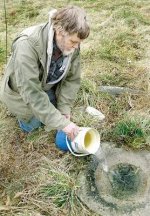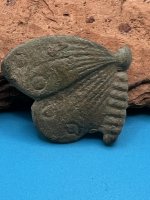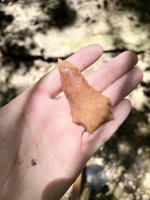Gypsy Heart
Gold Member
Wawayanda — Possibly the largest pre-colonial artifact in Orange County rests in a field of fescue in the Town of Wawayanda, just across the street from bulldozers and housing construction.
Bill Sandy, the archaeologist who identified the stone mortar used for grinding food, should be elated at making one of the great finds of his career.
But his excitement is tempered by the drilling and hammering all around him.
"The archaeological find is staggering," Sandy said, kneeling in front of the mortar. "But as you can see, the threat is staggering as well."
Wawayanda recently repealed a law meant to ensure the protection and documentation of significant cultural and historical sites before developers build on them. Without the cultural resource management law, it's possible that finds such as the stone mortar will go unprotected, Sandy said.
Wawayanda Councilwoman Gail Soro cast the single vote against the repeal and said that Supervisor John Randazzo and the other three councilmen view the cultural resource management law as anti-development. The law's repeal also defies the will of town residents, who consider protection of the area's agrarian heritage a top priority, according to a survey last year, she said.
Randazzo did not return calls for comment.
Minisink Valley residents are increasingly concerned with growth and its negative impact on the area's way of life, said Mike VanDervoort, a longtime resident of the area.
"(Rampant growth) is what's going on," VanDervoort said. "The school district is dealing with it, and now the towns are dealing with it."
The most vocal supporters of the resource management law come from the neighboring Town of Minisink's museum committee.
"Our area is a very historically interesting place, which we are still discovering," said Minisink's clerk and historian, Carol Van Buren, in a letter to the Times Herald-Record. "Once it is paved over or built upon, that opportunity for discovery is lost forever."
The law required that all new development sites get reviewed by the town historian and archaeologist before bulldozers moved in. If considered significant, a site would have undergone a study, including archaeology, photography and the recording of oral history.
Violators were fined $500 per day, and costs for the studies could range from a couple of hundred to a couple of thousand dollars. Wawayanda referred a total of 14 out of 34 sites for study last year, Van Buren said.
State law also requires historic reviews on significant sites, whether or not a town has a law. But instead of receiving immediate feedback from the local municipality, developers will now have to wait until decisions get back from Albany, Soro said.
And the state law assumes that developers will be forthcoming and knowledgeable enough to identify significant sites on their properties, said Erika Myers, a Wawayanda resident and Minisink Museum committee member.
"That would be like the fox guarding the henhouse," she said.
A rare find
The stone mortar and foot support buried in the field of grass were found "in situ," Latin meaning "in its place," according to archaeologist Bill Sandy.
Archaeologists have dug up similar artifacts all across America, but to see one in the same location left by its creators is rare, Sandy said.
"It's something you can touch that a native American might have touched (more than 200 years ago)," he said.
A stone foot support located three feet next to the mortar made it an even more unique find, Sandy said. Archaeologists know of no Indian mortar in the country with this addition.
If the mortar is indeed pre-colonial, the land around it could be the site of a settlement of native Americans we know little about, Sandy said. "This is a time capsule that might yield information about them," he said.
There is also the possibility that the mortar was built by colonists, who learned to make the tool from the Indians. If so, the mortar might offer a clue to perhaps an even greater treasure: the location of two lost fort settlements in the region, Sandy said.
Details about the site, located in a residential part of Wawayanda under development, are being kept secret for its protection.
The owner of the field where the stone was found, plans to leave it "in situ" for as long as possible, Sandy said.
"It's like a priceless piece of art; you wouldn't want to peel away the paint to see what's underneath it," he said.
http://www.recordonline.com/apps/pbcs.dll/article?AID=/20061219/NEWS/612190312/-1/NEWS
Bill Sandy, the archaeologist who identified the stone mortar used for grinding food, should be elated at making one of the great finds of his career.
But his excitement is tempered by the drilling and hammering all around him.
"The archaeological find is staggering," Sandy said, kneeling in front of the mortar. "But as you can see, the threat is staggering as well."
Wawayanda recently repealed a law meant to ensure the protection and documentation of significant cultural and historical sites before developers build on them. Without the cultural resource management law, it's possible that finds such as the stone mortar will go unprotected, Sandy said.
Wawayanda Councilwoman Gail Soro cast the single vote against the repeal and said that Supervisor John Randazzo and the other three councilmen view the cultural resource management law as anti-development. The law's repeal also defies the will of town residents, who consider protection of the area's agrarian heritage a top priority, according to a survey last year, she said.
Randazzo did not return calls for comment.
Minisink Valley residents are increasingly concerned with growth and its negative impact on the area's way of life, said Mike VanDervoort, a longtime resident of the area.
"(Rampant growth) is what's going on," VanDervoort said. "The school district is dealing with it, and now the towns are dealing with it."
The most vocal supporters of the resource management law come from the neighboring Town of Minisink's museum committee.
"Our area is a very historically interesting place, which we are still discovering," said Minisink's clerk and historian, Carol Van Buren, in a letter to the Times Herald-Record. "Once it is paved over or built upon, that opportunity for discovery is lost forever."
The law required that all new development sites get reviewed by the town historian and archaeologist before bulldozers moved in. If considered significant, a site would have undergone a study, including archaeology, photography and the recording of oral history.
Violators were fined $500 per day, and costs for the studies could range from a couple of hundred to a couple of thousand dollars. Wawayanda referred a total of 14 out of 34 sites for study last year, Van Buren said.
State law also requires historic reviews on significant sites, whether or not a town has a law. But instead of receiving immediate feedback from the local municipality, developers will now have to wait until decisions get back from Albany, Soro said.
And the state law assumes that developers will be forthcoming and knowledgeable enough to identify significant sites on their properties, said Erika Myers, a Wawayanda resident and Minisink Museum committee member.
"That would be like the fox guarding the henhouse," she said.
A rare find
The stone mortar and foot support buried in the field of grass were found "in situ," Latin meaning "in its place," according to archaeologist Bill Sandy.
Archaeologists have dug up similar artifacts all across America, but to see one in the same location left by its creators is rare, Sandy said.
"It's something you can touch that a native American might have touched (more than 200 years ago)," he said.
A stone foot support located three feet next to the mortar made it an even more unique find, Sandy said. Archaeologists know of no Indian mortar in the country with this addition.
If the mortar is indeed pre-colonial, the land around it could be the site of a settlement of native Americans we know little about, Sandy said. "This is a time capsule that might yield information about them," he said.
There is also the possibility that the mortar was built by colonists, who learned to make the tool from the Indians. If so, the mortar might offer a clue to perhaps an even greater treasure: the location of two lost fort settlements in the region, Sandy said.
Details about the site, located in a residential part of Wawayanda under development, are being kept secret for its protection.
The owner of the field where the stone was found, plans to leave it "in situ" for as long as possible, Sandy said.
"It's like a priceless piece of art; you wouldn't want to peel away the paint to see what's underneath it," he said.
http://www.recordonline.com/apps/pbcs.dll/article?AID=/20061219/NEWS/612190312/-1/NEWS
Attachments
Upvote
0






